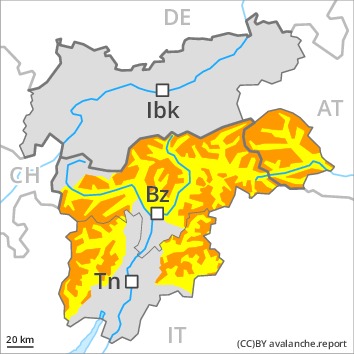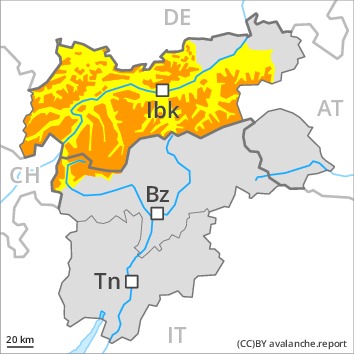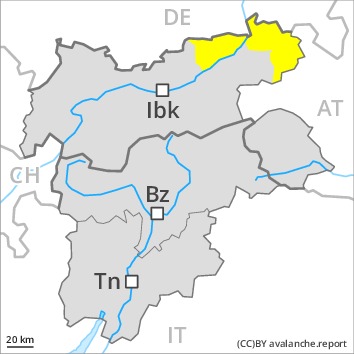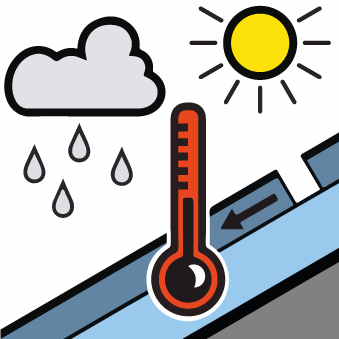
Danger level
 | 1900m
|
Avalanche Problem
 | | Persistent weak layer |
|  | |  |
 | | Gliding snow |
|  | |  |

Weakly bonded old snow and gliding snow are to be assessed with care and prudence.
Weak layers in the old snowpack can still be released in some places by individual winter sport participants. Caution is to be exercised in all aspects above approximately 1900 m, especially on very steep slopes, as well as at transitions from a shallow to a deep snowpack. Avalanches can also penetrate deep layers and reach dangerously large size. In addition the fresh wind slabs at high altitudes and in high Alpine regions are prone to triggering in some cases.
As a consequence of warming moist avalanches are possible. In addition there is a danger of gliding avalanches, also on shady slopes. Avalanches can reach large size in isolated cases.
Extensive experience in the assessment of avalanche danger is required.
Snowpack
dp.2: gliding snow
dp.7: snow-poor zones in snow-rich surrounding
Faceted weak layers exist in the centre of the snowpack. This applies in particular above approximately 1900 m.
As a consequence of a strong southwesterly wind, mostly small wind slabs will form in the course of the day, especially at high altitudes and in high Alpine regions.
Towards its base, the snowpack is largely stable.
The spring-like weather conditions will give rise to gradual moistening of the snowpack. Very steep sunny slopes and low and intermediate altitudes: The snowpack is moist and its surface has a melt-freeze crust that is barely capable of bearing a load.
Tendency
Slight decrease in danger of dry avalanches. The danger of gliding avalanches and moist snow slides will persist.

Danger level
 | 1900m
|
Avalanche Problem
 | | Persistent weak layer |
|  | |  |
 | | Gliding snow |
|  | |  |

In some places avalanches can be released in the weakly bonded old snow and reach large size.
A precarious avalanche situation will be encountered in some regions. This applies above approximately 1900 m. Between approximately 1900 and 2300 m the avalanche prone locations are more prevalent and the danger is greater. Even single winter sport participants can release avalanches. This applies in particular in areas where the snow cover is rather shallow, as well as at transitions from a shallow to a deep snowpack. Avalanches can penetrate deep layers and reach dangerously large size. Remotely triggered avalanches are possible. Extensive experience in the assessment of avalanche danger and great restraint are required.
As a consequence of warming gliding avalanches and moist snow slides are to be expected. Areas with glide cracks are to be avoided as far as possible.
In addition the fresh wind slabs are prone to triggering in some cases still. The avalanche prone locations are to be found adjacent to ridgelines above approximately 2200 m. The prevalence of avalanche prone locations and likelihood of triggering will increase with altitude.
Snowpack
dp.7: snow-poor zones in snow-rich surrounding
dp.2: gliding snow
Avalanche prone weak layers exist in the centre of the snowpack. This applies above approximately 1900 m, especially between approximately 1900 and 2300 m in all aspects. Released avalanches and stability tests confirm the existence of a weak snowack. Towards its base, the snowpack is faceted.
The wind slabs of the last few days are lying on soft layers, especially on shady slopes at high altitudes and in high Alpine regions.
The spring-like weather conditions will give rise to gradual moistening of the snowpack. The snowpack will be moist at intermediate altitudes. The snowpack will be wet all the way through at low altitude.
Tendency
A precarious avalanche situation will be encountered in some regions.

Danger level
 | 1900m
|
Avalanche Problem
 | | Persistent weak layer |
|  | |  |
 | | Wet snow |
|  | |  |

Weakly bonded old snow represents the main danger.
Weak layers in the old snowpack can still be released in some places by individual winter sport participants in particular above approximately 1900 m.
As a consequence of warming individual moist avalanches are possible as the day progresses, but they will be mostly small. Caution is to be exercised in particular on extremely steep sunny slopes.
Snowpack
dp.7: snow-poor zones in snow-rich surrounding
Avalanche prone weak layers exist in the centre of the snowpack. This applies in particular above approximately 1900 m. The spring-like weather conditions will give rise to gradual moistening of the snowpack. The snowpack will be moist at intermediate altitudes. The snowpack will be wet all the way through at low altitude.
Tendency
The avalanche danger will persist.

Danger level
 | 2200m
|
Avalanche Problem
 | | Wind-drifted snow |
|  | |  |
 | | Persistent weak layer |
|  | |  |

Wind slabs and weakly bonded old snow require caution.
As a consequence of a strong southwesterly wind, sometimes avalanche prone wind slabs will form in the course of the day. This applies in particular on east, north and southeast facing slopes above approximately 2200 m. Caution is to be exercised in particular on very steep slopes, as well as at transitions from a shallow to a deep snowpack. Avalanches can additionally in isolated cases be released in the weakly bonded old snow, mostly by large additional loads.
As a consequence of warming moist avalanches are possible. In addition there is a danger of gliding avalanches, also on shady slopes.
Snowpack
dp.2: gliding snow
dp.7: snow-poor zones in snow-rich surrounding
On Wednesday the wind will be strong over a wide area. The southwesterly wind will transport the old snow. The fresh wind slabs are prone to triggering, especially at high altitudes and in high Alpine regions.
Faceted weak layers exist in the centre of the snowpack. Towards its base, the snowpack is largely stable.
The spring-like weather conditions will give rise to gradual moistening of the snowpack. Very steep sunny slopes and low and intermediate altitudes: The snowpack is moist and its surface has a melt-freeze crust that is barely capable of bearing a load.
Tendency
Slight decrease in danger of dry avalanches. The danger of gliding avalanches and moist snow slides will persist.















